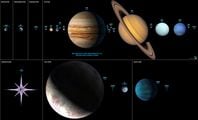Sol system
From Halopedia, the Halo wiki
| There is more information available on this subject at Sol system on the English Wikipedia. |
The Sol system, also referred to as the Sol star system, is the home star system of the human species.[1] Earth, the human homeworld, holds the seat of power for both the Unified Earth Government,[2] and the United Nations Space Command.[3]
History
Humanity first colonized the system's worlds beyond Earth in the late 21st and early 22nd centuries, followed by steady growth of the populations on Earth and the off-world colonies throughout the next two centuries before the launch of the first extrasolar colonization program in 2362, enabled by the development of the Shaw-Fujikawa Translight Engine in 2291.[4]
Attacks on the system
The first incursion into the Sol System was on October 10, 2552 by unknown enemies.[5]
On October 20, the Fleet of Sacred Consecration was detected near the moon of Io. Soon after, the Fleet appeared near Earth, commencing the Battle for Earth.[6] Over the next few months, battles on Earth and elsewhere in the system would take place. The Battle of Mare Erythraeum on Mars would take place during this time frame.[7] The UNSC Home Fleet would be utterly devastated by November 17 with the arrival of the Anodyne Spirit and Truth's fleet.[8] The final skirmish on Earth would take place on December 3, during Operation: MARSH FLASH.[5]
Many of the human habitats in the system survived the assault relatively intact.[9]
Planetary system
- Mercury - Innermost planet in the Sol System.
- Venus - Failed terraforming project.
- Earth - The human homeworld,[1] home to the headquarters of the UEG[2] and the UNSC.[3] Also the site of Kupiga Simu, a Sol system communications transmitter.[1]
- Luna - Earth's only natural satellite. Home to Sol's oldest Officer Candidate School, the famed Luna OCS Academy.[10]
- Mars - One of humanity's first interplanetary colonies, Mars has been terraformed to have an Earth-like climate. Was the site of a decisive battle in the Interplanetary Wars.
- Jupiter - A gas giant, Jupiter is the largest planet in the Sol System.
- Io - The site of a UNSC listening post. On October 20, 2552, the listening post on Io detected 15 Covenant ships inbound under the command of the Prophet of Regret.[6]
- Europa - It contains a UNSC base and a substantial colony. Spartans Linda-058 and Will-043 were once assigned to a mission on this satellite.
- Callisto - The second-largest Jovian Moon. The site of the signing of the Callisto Treaty and a number of UNSC bases.
- Ganymede - The EVA Armor was developed here; also home to a number of colonists.
- Saturn - A gas giant known for its clearly visible surrounding rings, unlike the other gas giants whose rings are rather dim. Saturn is the second largest planet in the Sol System. Its practical uses to the UNSC are limited, and therefore it is mostly just a tourist destination.[11] Castellaneta, a tourist station, is in geosynchronous orbit on the "sunny side" of the planet's outermost ring.[12]
- Uranus - An icy gas giant about twice as far away as Saturn from Sol. Its distance from Sol makes it of little use to the UNSC.
- 2011 QF99 - One of Uranus' trojan asteroids, it features an anomaly of some kind and is surrounded by an exclusion zone.[13]
- Neptune - Furthest away from Sol, it is another icy gas giant similar to Uranus.
- Ixion - a plutino in the outer Sol system, which has been colonised by humanity.
- Pluto - Originally discovered in the 1930s and initially classified as the Solar System's ninth planet, Pluto was reclassified as a dwarf planet in 2006. The Pluto Slipstream monitoring station Democritus is stationed in orbit around it. On November 3, 2552, the Monitoring Station detected Cortana's signal in Slipspace with Dr. Halsey's message to Lord Hood. Pluto has five moons: Nix, Hydra, Charon, Kerberos, and Styx.
- Shaw Institute Facility
- Oort cloud
Trivia
- Sol is the original Latin and the actual scientific name for Earth's sun. This designation and name has actually been used instead of "Solar System" in many science fiction novels.
- Sol is also an emblem option in Halo 3 and Halo: Reach.
Gallery
A size comparison between Threshold, Alpha Halo, Installation 00, Arcadia, Reach, Harvest and planets in the Solar System.
List of appearances
Sources
- ^ a b c Halo Waypoint: Earth
- ^ a b Halo Waypoint: UEG
- ^ a b Halo Waypoint: UNSC
- ^ Halo Encyclopedia, p. 43-44 (2011)
- ^ a b Halo Legendary Crate, Data Drop #2
- ^ a b Halo 2, campaign level, Cairo Station
- ^ Halo: Uprising
- ^ Halo 3, campaign level, Crow's Nest
- ^ Halo Waypoint: Humans
- ^ Halo: Reach Limited Edition, Intersystem News, LCDR Miranda Keyes Awarded Silver Star
- ^ Halo Encyclopedia, p. 283
- ^ Halo: New Blood, p. 26-27
- ^ Halo Mythos, p. 51
